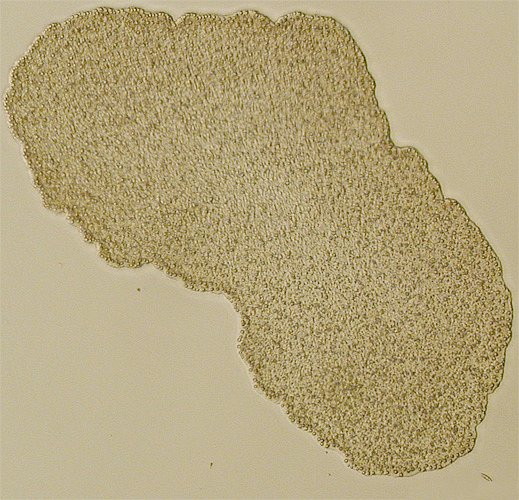 I was intrigued by a brief news piece in the latest issue of Science to fall onto my desk (the 22nd August issue). This concerns the recently published genome sequence of Trichoplax adhaerens, a peculiar animal in a phylum I'd never heard of. That in itself was interesting, particularly as placozoans have a really odd body plan that involves a mere four cell types. Wikipedia has a nice description of Placozoa, from which the image below comes.
I was intrigued by a brief news piece in the latest issue of Science to fall onto my desk (the 22nd August issue). This concerns the recently published genome sequence of Trichoplax adhaerens, a peculiar animal in a phylum I'd never heard of. That in itself was interesting, particularly as placozoans have a really odd body plan that involves a mere four cell types. Wikipedia has a nice description of Placozoa, from which the image below comes.

On browsing the web a bit further, I found this movie (Quicktime format) of a placozoan moving. I presume this would be Trichoplax adhaerens, as this is the only known species in the phylum - a second described species, T. reptans, was apparently described at the end of the 19th century but hasn't ben seen again and it's existence is doubtful.
Trichoplax appears to have no sensory cells, muscle cells, or a nervous system - it glides over the substrate using cilited cells on its underside, secreting enzymes to digest food - food is digested externally and via phagocytosis.
The full citation for the genome paper is Srivastava et al (2008) The Trichoplax genome and the nature of placozoans. Nature 454;955 (doi:10.1038/nature07191). Full Text; pdf (The paper is released under the creative commons licence, so should be available)
The general picture about the Trichoplax genome is: 98 megabases, distributed over six chromosomes, and containing 11,514 protein coding genes (only a couple of thousand fewer than my favourite system, Drosophila). The sequence has answered quite a few questions about where the phylum Placozoa fits into the animal kingdom: it appears they branched after sponges, but before Cnidaria (the jellyfishes, corals and sea anemones). There may well be more complexity within the apparently simple tissue structures of these organisms. Trichoplax has a wider variety of genes than one might expect for such a simple body plan: this might reflect the origins of genes which are used inthe development of a wide variety of cell types in more complex organisms. Alternatively, Placozoa may merely be a phase in an otherwise undiscovered life cycle.
Above: the deduced phylogenetic position of Placozoa (from Srivastava et al (2008).
Mansi Srivastava, Emina Begovic, Jarrod Chapman, Nicholas H. Putnam, Uffe Hellsten, Takeshi Kawashima, Alan Kuo, Therese Mitros, Asaf Salamov, Meredith L. Carpenter, Ana Y. Signorovitch, Maria A. Moreno, Kai Kamm, Jane Grimwood, Jeremy Schmutz, Harris Shapiro, Igor V. Grigoriev, Leo W. Buss, Bernd Schierwater, Stephen L. Dellaporta, Daniel S. Rokhsar (2008). The Trichoplax genome and the nature of placozoans Nature, 454 (7207), 955-960 DOI: 10.1038/nature07191
